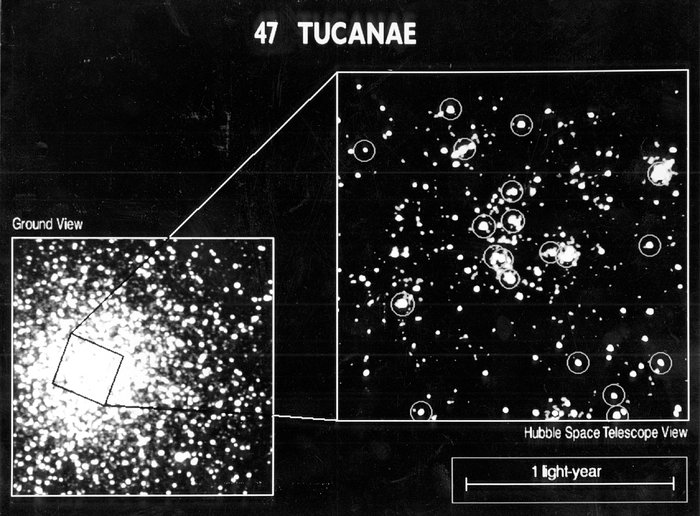47 Tucanae core - ground based vs. HST resolution
[RIGHT] The core of the globular cluster 47 Tucanae, as imaged by the European Space Agency's Faint Object Camera (FOC) onboard NASA/ESA Hubble Space Telescope. The FOC resolves several hundred stars where ground-based images only yield a few dozen stars. The image reveals so-called blue straggler stars (encircled) which are exceptionally bright in ultraviolet light. HST's UV sensitivity and high resolution allow it to easily separate the blue stragglers from the red giant stars which dominate the cluster.
Blue straggler stars may evolve from "old age" back to a hotter and brighter youth through stellar collisions and mergers. This high concentration of blue stragglers towards the core of 47 Tucanae suggests they are significantly more massive than most of the cluster's stars. Some of blue stragglers could be massive because they are really double star systems. Such binary systems may influence the motions of thousands of other stars within the cluster. The FOC observations were made in ultraviolet light (2200 angstroms) on November 16, 1990 with the FOC in F/96 mode. Field of view is 11 X 11 arc seconds corresponding to a width of .75 light years, at 47 Tucanae's distance of 15,000 light years. Resolution is 0.1 arc second.
Credit:About the Image
About the Object
| Name: | 47 Tucanae, NGC 104 |
| Type: | Milky Way : Star : Grouping : Cluster : Globular |
| Distance: | 15000 light years |
| Category: | Star Clusters |
Colours & filters
| Band | Wavelength | Telescope |
|---|---|---|
| Ultraviolet Mid-UV | 220 nm |
Hubble Space Telescope
FOC |
| Optical B | 440 nm |
MPG/ESO 2.2-metre telescope
WFI |
